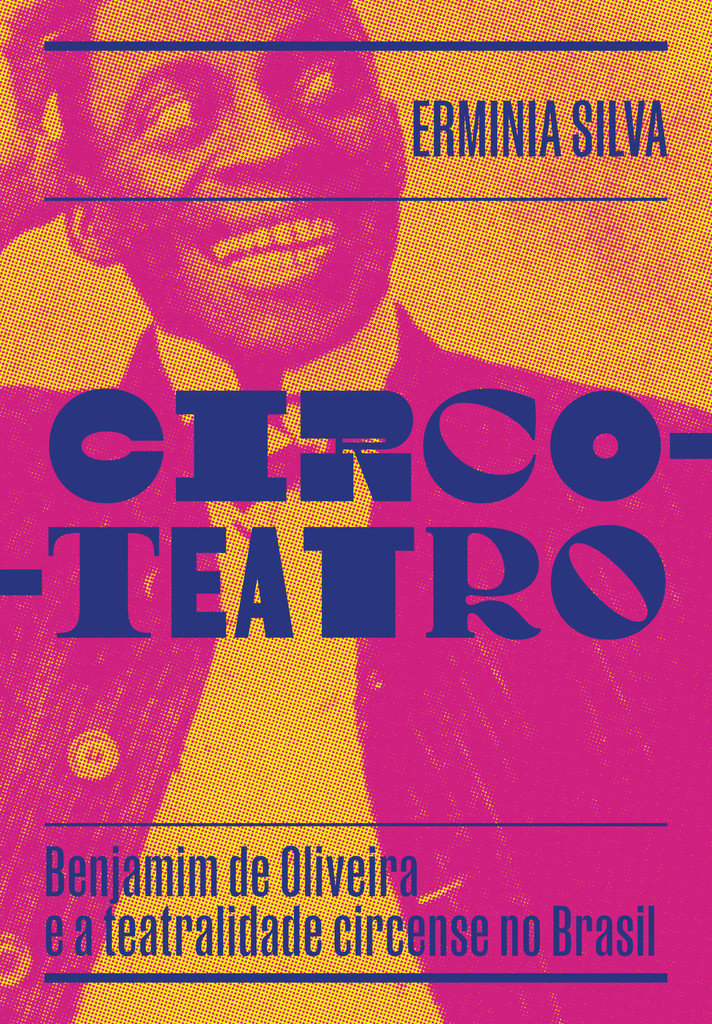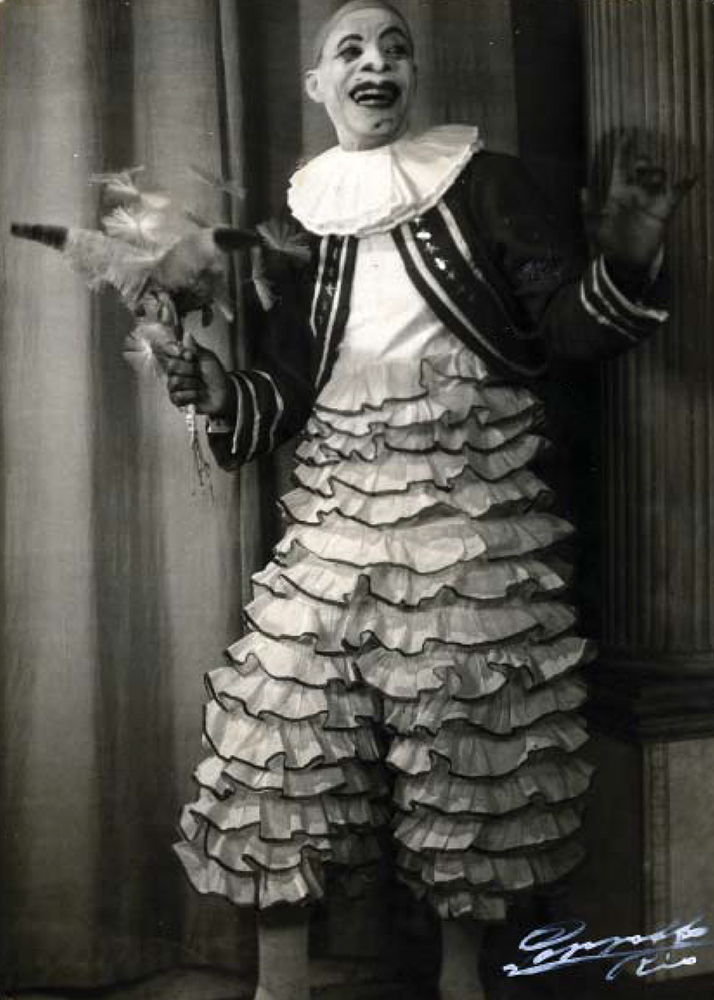Benjamim de Oliveira (1870–1954), a Black man born to enslaved parents, was an iconic Brazilian clown and multi-instrumentalist.
The extraordinary trajectory of Benjamim Chaves (Oliveira’s birth name) and its impact on circus arts in Brazil was the central topic of Ermínia Silva’s Ph.D. thesis, which was completed at the Institute of Philosophy and Human Sciences (IFCH) at the University of Campinas in 2003. Years later, Silva’s study gave rise to the first edition of the book Circo-Teatro: Benjamim de Oliveira e a teatralidade circense no Brasil (2007), which was then revised and expanded fifteen years later in its second edition (2022).
Ermínia Silva’s research, now considered a milestone in the history of circus in Brazil, gave rise to a profound change in the field by moving away from the hegemonic notion of history built by a systematic organization of facts and events toward a contextualized and critical interpretation of history.
The first edition printed in 2007
The book begins with a robust narrative about one of the most important art forms during the transition between the nineteenth and twentieth centuries (1870–1910): the Circus-Theatre (Silva, 2015). Silva’s arguments consistently reinforce the importance of circus to the development of theatre in Brazil (Marques, 2010).
Silva’s thesis was formulated based on exhaustive documentary research (with newspapers as primary sources) discussing the dialectical relationship between tradition and innovation; together, tradition and innovation intertwine to make circus a dynamic art form based on multicultural development specific to each historical context. This proposed perspective opposes many previous studies, which had defended a historical rift between the “classic/traditional” circus and the “contemporary” circus. This previous understanding is, in Silva’s opinion, a serious historical mistake.
In this deep dive into the history of circus in Brazil, readers will find narratives about the trajectories of several circus companies, circus families and artists, as well as outstanding facts intertwined with Benjamim de Oliveira’s unique journey. The narrative is carefully supported by historical data (documentary sources) that allow for a historical-cultural analysis that includes several anthropological notes (Hirano, 2008). The quality of the interpretation of this historical context motivated heated debates, showing an unusual scientific rigour for much of the historical production of the modern circus, even beyond Brazil’s borders.
Based on a disruptive framework and always following the footprints Benjamim de Oliveira left behind, the book shines a historical spotlight on the voices of the subordinate classes of society that have often been silenced. Black artists have made numerous significant contributions to the development of the arts (e.g., music, theatre, dance and circus) in Brazil, but are largely invisible in documentation. This injust treatment, has omitted many Black artists from historical records. Although it is not mentioned in the book, Benjamim de Oliveira’s trajectory was similar to those of many other Black artists, namely Rafael Padilla, who was portrayed in the renowned French film Chocolat (2016), directed by Roschdy Zem.
Silva’s book emphasizes Oliveira’s artistic qualities and multiple skills, which allowed him to move both within and without the context of circus to become a recognized personality of his time—an unusual occurrence, even decades after the abolition of slavery in Brazil was made official on 13 May 1888.
Benjamim de Oliveira is presented as an elegant, eloquent artist and as a person who disturbed society at the time, paving the way for a delayed and more-than-deserved recognition of Black artists. According to Silva, he rocked the performing arts scene—which was still strongly aristocratic at the time—and provoked a wide range of often contrasting reactions, from discontent to relief, from fascination to astonishment, depending on the critic’s position or perspective. Oliveira broke social barriers at the beginning of the twentieth century, which placed many art critics and influential people on his side, many of whom later became promoters of the Brazilian circus. Silva’s book highlights the enormous social recognition that the circus has achieved as and the echoes of those times help consolidate the modern Brazilian imagery surrounding circus art (Silva, 2015).
In its last pages, the book presents an extensive catalogue of circus-theatre plays staged in Brazilian circuses between 1834 and 1912. Silva seemingly anticipated the need for greater sharing of data sources to encourage the dynamization and democratization of scientific research.
The book reveals numerous voices, people and artists who were not part of the popular knowledge or imagination of circus arts at the time; by “holding Benjamim’s hands,” as Silva puts it, the reader is encouraged to learn the stories of a multitude of anonymous artists who were invisible to most theatre, dance, music and circus-related historical studies. In an elegant and consistent way, Silva’s work leads us to question the greater prominence given to many other (wonderfully talented) white clowns (Arrelia, Cascão, Torresmo, Picolino, etc.) for decades, raising the question: “Does one need to be white to become an iconic circus artist?”
As the book progresses, Silva guides us toward an understanding that the history of Black artists continues to be marginalized to this day. Sometimes even erased! Silva’s work also allowed fellow researchers to tell the stories of many other Black artists, including several clowns who came before Benjamim de Oliveira’s time as well as his contemporaries (Bernardo, 2023).
The second revised and expanded edition
It should be noted that the first edition of the book sold out and became a desired collector’s piece. In 2022, the second edition was finally released and it is now available both digitally and in hardcopy. The electronic version is available through open access thanks to a partnership between one of Brazil’s most important cultural foundations, Itaú Cultural, and the Martins Fontes publishing house.
By studying Benjamim de Oliveira, it is possible to understand how this iconic Black clown refused to accept the subordinate role reserved for him by the dominant white culture. This historic struggle continues today, both within and without artistic contexts (McCarthy-Brown, 2011).
The Brazilian playwright Luís Alberto de Abreu reinforces another important contribution of Silva’s work in the prologue of the second edition:
As this observation demonstrates, the Black ancestry, value, knowledge and power discussed in Silva’s book have revitalized current debates surrounding narrative and visibility.Ermínia, em sua pesquisa, nos revela outros “Benjamims,” outros palhaços cantores negros, artistas de talentos múltiplos. Eduardo das Neves e Baiano foram também artistas circenses múltiplos, negros, inventivos e empreendedores e, se não tiveram a projeção de Benjamim de Oliveira, se deve a fatores outros que não o potencial criativo. (Silva, 2022, 24)
[Ermínia, in her research, reveals other “Benjamims,” other Black singing clowns and artists with multiple talents. Eduardo das Neves and Baiano were also multi-talented circus artists, Black, inventive and enterprising, and if they did not have the same reach as Benjamim de Oliveira, it is due to factors other than their creative potential.] (Silva, 2022, 24; our translation).
Although some studies claim that Benjamim de Oliveira was the first Black clown in Brazil, Silva disagrees with this reductive and simplistic understanding. In her opinion, his influence is enormous. However, it should be studied alongside many other artists of his era. According to Silva, historical research is an inexhaustible effort that must be in dialogue with historical time, the culture and people of the era, and disputes over memories and narratives.
Twenty-five years after beginning the research that culminated in the book’s creation and more than a decade after the first edition’s publication, Silva accepted the challenge of revisiting her sources and expanding her work. To carry out this task, she reached out to Dr. Daniel de Carvalho Lopes, who contributed a new chapter entitled “Hand-in-hand with Benjamim: What Do We See and Experience?”
Few scholars accept the challenge of “self-reviewing,” of broadening the search for sources in their various formats and therefore diving back into the complexity of the research. Ermínia Silva did not hesitate, demonstrating that her intellectual and political militancy is as active now as it was in the past. The book’s second edition includes new documentation and promotes new encounters with the living past and present of circus. As the author herself commented in a recent conversation, the second edition of the book involved the addition of new sources, questions and perspectives, as well as the accumulation of 25 years of exchanging, dialoguing and incorporating—but especially learning that there are always emotions and intersections stemming from encounters and connections between different people.
In this sense, the four chapters have been revised and expanded to create a living past. In the fifth chapter by Dr. Daniel de Carvalho Lopes, the concept that author Heloísa Pires Lima described when researching the few, almost non-existent records of Benjamim de Oliveira in his own city of birth, Pará de Minas, was defined as a “national and municipal amnesia.” Between the 2009 and 2022 editions, Silva, Lopes and Lima dialogued, contributing to the transition from a state of invisibility to a fruitful production in Pará de Minas. The City Museum became a promoter of the stories of Beijo (Oliveira’s nickname), and from 2009 until today, the Clown Festival of Pará de Minas (ARABENJAMIM) has been held simultaneously with the World Circus Festival in Belo Horizonte.
Ermínia Silva’s masterful portrait of Benjamim de Oliveira and, more broadly, of the history of circus in Brazil—which, unfortunately, has not yet been translated into other languages—has become an essential reference for Brazilian circus arts. Oliveira’s legacy continues to inspire generations of Black artists who continue to contribute meaningfully to the development of Brazilian circus culture both locally and internationally. Silva’s book teaches us to rethink the history of art and, whenever possible, tell it again with a more careful and broader look at its protagonists.
References
Benjamim de Oliveira. Enciclopédia Itaú Cultural de Arte e Cultura Brasileira, Itaú Cultural, 2024, https://enciclopedia.itaucultural.org.br/pessoa6689/benjamim-de-oliveirahttps://enciclopedia.itaucultural.org.br/pessoa6689/benjamim-de-oliveira
Bernardo, André. “Do picadeiro ao cinema: a história de Benjamim de Oliveira, o palhaço negro do Brasil.” BBC News, 11 February 2023. bbc.com/portuguese/articles/c0dl1pevp3wobbc.com/portuguese/articles/c0dl1pevp3wo
Hirano, Luis Felipe Kojima. “Circo-Teatro: Benjamim de Oliveira e a teatralidade circense no Brasil.” Ponto Urbe, vol. 2, 2008. https://doi.org/10.4000/pontourbe.1923https://doi.org/10.4000/pontourbe.1923
McCarthy-Brown, Nyama. “Dancing in the Margins: Experiences of African American Ballerinas.” Journal of African American Studies, vol. 15, 2011, pp. 385–408. https://doi.org/10.1007/s12111-010-9143-0https://doi.org/10.1007/s12111-010-9143-0
Silva, Ermínia “Family-Circus, Theater-Circus: It is Theater in the Circus.” Brazilian Theater, 1970–2010. Essays on History, Politics and Artistic Experimentation, edited by Eva Paulino Bueno & Robson Corrêa de Camargo, McFarland & Company, 2015, pp. 126–140.



